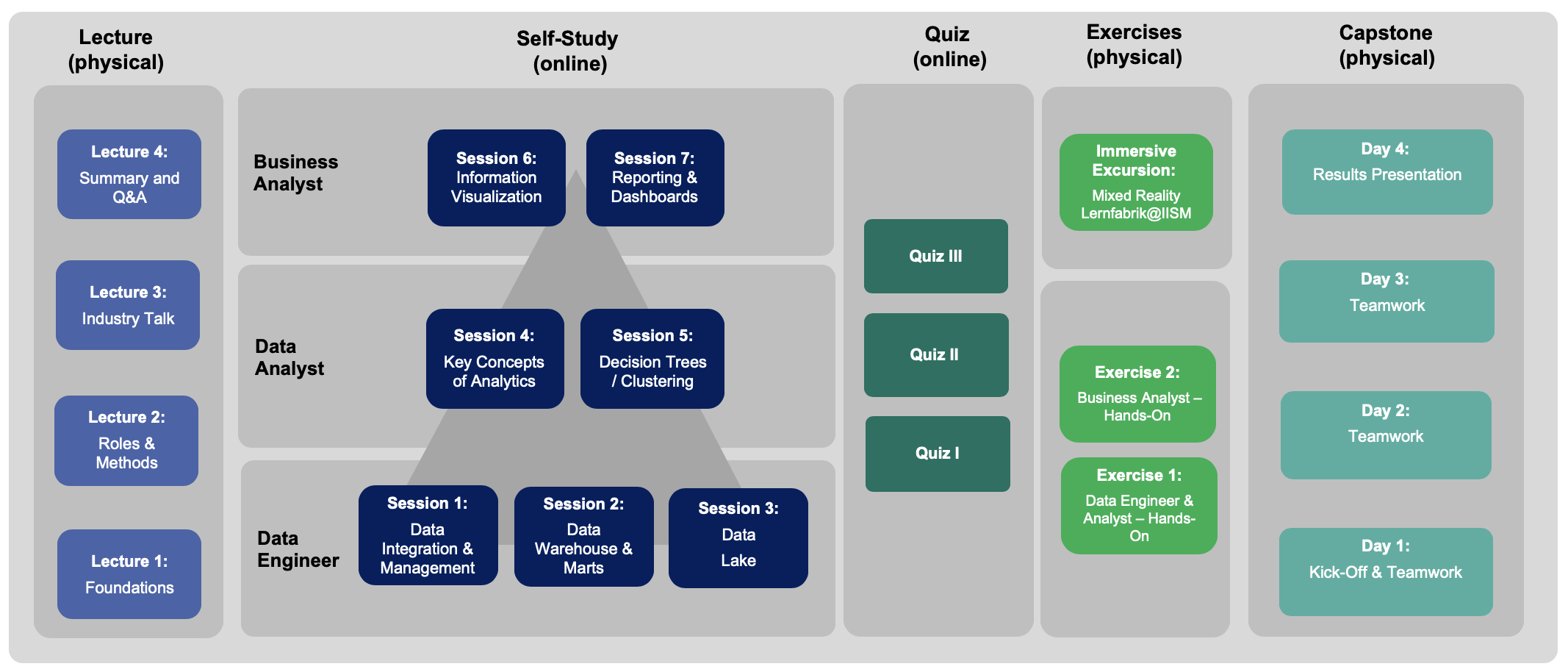Business Intelligence Systems
- Type: Lecture (V)
- Semester: WS 22/23
-
Time:
Th 2022-10-27
09:45 - 11:15, weekly
10.11 Sitzungssaal Hauptgebäude (R223)
10.11 Verwaltungsgebäude, Hauptbau (OG 2)
Th 2022-11-03
09:45 - 11:15, weekly
10.11 Sitzungssaal Hauptgebäude (R223)
10.11 Verwaltungsgebäude, Hauptbau (OG 2)
Th 2022-11-10
09:45 - 11:15, weekly
10.11 Sitzungssaal Hauptgebäude (R223)
10.11 Verwaltungsgebäude, Hauptbau (OG 2)
Th 2022-11-17
09:45 - 11:15, weekly
10.11 Sitzungssaal Hauptgebäude (R223)
10.11 Verwaltungsgebäude, Hauptbau (OG 2)
Th 2022-11-24
09:45 - 11:15, weekly
10.11 Sitzungssaal Hauptgebäude (R223)
10.11 Verwaltungsgebäude, Hauptbau (OG 2)
Th 2022-12-01
09:45 - 11:15, weekly
10.11 Sitzungssaal Hauptgebäude (R223)
10.11 Verwaltungsgebäude, Hauptbau (OG 2)
Th 2022-12-08
09:45 - 11:15, weekly
10.11 Sitzungssaal Hauptgebäude (R223)
10.11 Verwaltungsgebäude, Hauptbau (OG 2)
Th 2022-12-15
09:45 - 11:15, weekly
10.11 Sitzungssaal Hauptgebäude (R223)
10.11 Verwaltungsgebäude, Hauptbau (OG 2)
Th 2022-12-22
09:45 - 11:15, weekly
10.11 Sitzungssaal Hauptgebäude (R223)
10.11 Verwaltungsgebäude, Hauptbau (OG 2)
Th 2023-01-12
09:45 - 11:15, weekly
10.11 Sitzungssaal Hauptgebäude (R223)
10.11 Verwaltungsgebäude, Hauptbau (OG 2)
Th 2023-01-19
09:45 - 11:15, weekly
10.11 Sitzungssaal Hauptgebäude (R223)
10.11 Verwaltungsgebäude, Hauptbau (OG 2)
Th 2023-01-26
09:45 - 11:15, weekly
10.11 Sitzungssaal Hauptgebäude (R223)
10.11 Verwaltungsgebäude, Hauptbau (OG 2)
Th 2023-02-02
09:45 - 11:15, weekly
10.11 Sitzungssaal Hauptgebäude (R223)
10.11 Verwaltungsgebäude, Hauptbau (OG 2)
Th 2023-02-09
09:45 - 11:15, weekly
10.11 Sitzungssaal Hauptgebäude (R223)
10.11 Verwaltungsgebäude, Hauptbau (OG 2)
Th 2023-02-16
09:45 - 11:15, weekly
10.11 Sitzungssaal Hauptgebäude (R223)
10.11 Verwaltungsgebäude, Hauptbau (OG 2)
- Lecturer:
- SWS: 3
- Lv-No.: 2540422
- Information: Blended (On-Site/Online)
| Content |
In most modern enterprises, Business Intelligence & Analytics (BI&A) Systems represent a core enabler of decision-making in that they are supplying up-to-date and accurate information about all relevant aspects of a company’s planning and operations: from stock levels to sales volumes, from process cycle times to key indicators of corporate performance. Modern BI&A systems leverage beyond reporting and dashboards also advanced analytical functions. Thus, today they also play a major role in enabling data-driven products and services. The aim of this course is to introduce theoretical foundations, concepts, tools, and current practice of BI&A Systems from a managerial and technical perspective.
The course is complemented with an engineering capstone project, where students work in a team with real-world use cases and data in order to create running Business intelligence & Analytics system prototypes.
Learning objectives
Prerequisites This course is limited to a capacity of 50 places. The capacity limitation is due to the attractive format of the accompanying engineering capstone project. Strong analytical abilities and profound skills in SQL as wells as Python and/or R are required. Students have to apply with their CV and transcript of records. All organizational details and the underlying registration process of the lecture and the capstone project will be presented in the first lecture (27.10.2022) and the registration will be open until 06.11.2022 (23:55). The teaching language is English. |
| Course Organization |  |
| Language of instruction | English |
| Bibliography |
Further literature will be made available in the lecture. |

